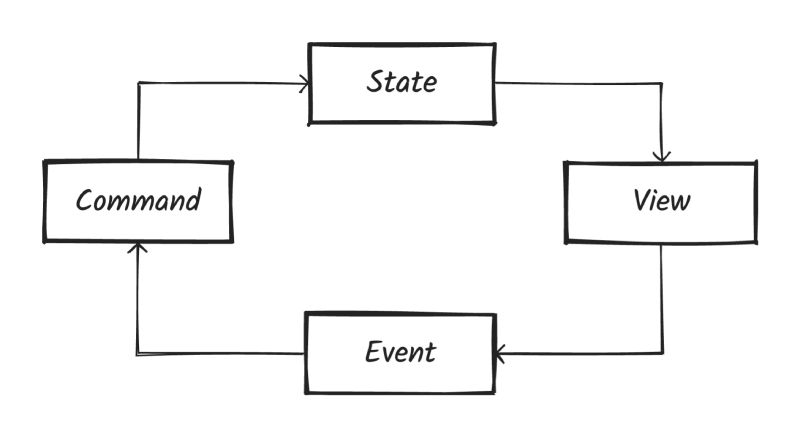Unidirectional Data Flow
To make the editor logic based on BlockSuite intuitive and collaboration-ready, there is one major goal in BlockSuite: Regardless of whether it is in a multi-user collaboration state, the application-layer code based on BlockSuite should be unaware of it.
We will introduce how this design is embodied in BlockSuite.
CRDT as Single Source of Truth
Traditionally, CRDTs have often been seen as a technology specialized in conflict resolution. Many editors initially designed to support single users have implemented support for real-time collaboration by integrating CRDT libraries. To this end, the data models in these editors will be synchronized to the CRDTs. This usually involves two opposite data flows:
- When the local model is updated, the state of the native model is synchronized to the CRDT model.
- When a remote peer is updated, the data resolved from the CRDT model is synchronized back to the native model.

Although this is an intuitive and common practice, it requires synchronization between two heterogeneous models, resulting in a bidirectional data flow. The main issues here are:
- This bidirectional binding is not that easy to implement reliably and requires non-trivial modifications.
- Application-layer code often needs to distinguish whether an update comes from a remote source, which increases complexity.
As an alternative, BlockSuite chooses to directly use the CRDT model as the single source of truth (since BlockSuite uses Yjs, we also call it YModel here). This means that regardless of whether the update comes from local or remote sources, the same process will be performed:
- Firstly modify YModel, triggering the corresponding
Y.Eventthat contains all incremental state changes in this update. - Update the model nodes in the block tree based on the
Y.Event. - Send corresponding slot events after updating the block model, so as to update UI components accordingly.
This design can be represented by the following diagram:

The advantage of this approach is that the application-layer code can completely ignore whether updates to the block model come from local editing, history stack, or collaboration with other users. Just subscribing to model update events is adequate.
INFO
In BlockSuite, we generally refer to the block instances that users manipulate through the page API as block models, but the true source of the state of these models comes from their underlying CRDT data structure, which is usually referred to as YBlock in our documentation.
Case Study
As an example, suppose the current block tree structure is as follows:
PageBlock
NoteBlock
ParagraphBlock 0
ParagraphBlock 1
ParagraphBlock 2PageBlock
NoteBlock
ParagraphBlock 0
ParagraphBlock 1
ParagraphBlock 2Now user A selects ParagraphBlock 2 and presses the delete key to delete it. At this point, page.deleteBlock should be called to delete this block model instance:
const blockModel = page.root.children[0].children[2];
page.deleteBlock(blockModel);const blockModel = page.root.children[0].children[2];
page.deleteBlock(blockModel);At this point, BlockSuite will not directly modify the block tree under page.root, but will instead firstly modify the underlying YBlock. After the CRDT state is changed, Yjs will generate the corresponding Y.Event data structure, which contains all the incremental state changes in this update (similar to patches in git and virtual DOM). BlockSuite will always use this as the basis to synchronize the block models, then trigger the corresponding slot events for UI updates.
In this example, as the parent of ParagraphBlock 2, the model.childrenUpdated slot event of NoteBlock will be triggered. This will enable the corresponding component in the UI framework component tree to refresh itself. Since each child block has an ID, this is very conducive to combining the common list key optimizations in UI frameworks, achieving on-demand block component updates.
But the real power lies in the fact that if this block tree is being concurrently edited by multiple people, when user B performs a similar operation, the corresponding update will be encoded by Yjs and distributed by the provider. When User A receives and applies the update from User B, the same state update pipeline as local editing will be triggered. This makes it unnecessary for the application to make any additional modifications or adaptations for collaboration scenarios, inherently gaining real-time collaboration capabilities.
Modeling Editor State
In a typical editor, besides the block tree mentioned above, this data flow also applies to:
- Per-user selection state and more user metadata.
- Local state that are not synchronized with other users.
These states may not be recorded in history, but their
A more comprehensive real-world data flow works in this manner:

For the new concepts involved, see command, view and event sections for more information.
Summary
In summary, by utilizing the CRDT model as the single source of truth, the application layer code can remain agnostic to whether updates originate from local or remote sources. This simplifies synchronization and reduces complexity. This approach enables applications to acquire real-time collaboration capabilities without necessitating intrusive modifications or adaptations, which is a key reason why the BlockSuite editor has been inherently collaborative from day one.